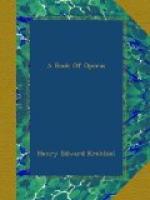and Bartolo brings in his ward to receive her music
lesson. Here, according to tradition, there stood
in the original score a trio which was lost with the
overture. Very welcome has this loss appeared
to the Rosinas of a later day, for it has enabled
them to introduce into the “lesson scene”
music of their own choice, and, of course, such as
showed their voices and art to the best advantage.
Very amusing have been the anachronisms which have
resulted from these illustrations of artistic vanity,
and diverting are the glimpses which they give of
the tastes and sensibilities of great prime donne.
Grisi and Alboni, stimulated by the example of Catalani
(though not in this opera), could think of nothing
nobler than to display their skill by singing Rode’s
Air and Variations, a violin piece. This grew
hackneyed, but, nevertheless, survived till a comparatively
late day. Bosio, feeling that variations were
necessary, threw Rode’s over in favor of those
on “Gia della mente involarmi”—a
polka tune from Alary’s “A Tre Nozze.”
Then Mme. Gassier ushered in the day of the vocal
waltz—Venzano’s, of amiable memory.
Her followers have not yet died out, though Patti
substituted Arditi’s “Il Bacio” for
Venzano’s; Mme. Sembrich, Strauss’s
“Voce di Primavera,” and Mme. Melba,
Arditi’s “Se saran rose.” Mme.
Viardot, with a finer sense of the fitness of things,
but either forgetful or not apprehensive of the fate
which befell her father at the first performance of
the opera in Rome, introduced a Spanish song.
Mme. Patti always kept a ready repertory for the
scene, with a song in the vernacular of the people
for whom she was singing to bring the enthusiasm to
a climax and a finish: “Home, Sweet Home”
in New York and London, “Solovei” in St.
Petersburg. Usually she began with the bolero
from “Les Vepres Siciliennes,” or the
shadow dance from “Dinorah.” Mme.
Seinbrich, living in a period when the style of song
of which she and Mme. Melba are still the brightest
exemplars, is not as familiar as it used to be when
they were children, also found it necessary to have
an extended list of pieces ready at hand to satisfy
the rapacious public. She was wont at first to
sing Proch’s Air and Variations, but that always
led to a demand for more, and whether she supplemented
it with “Ah! non giunge,” from “La
Sonnambula,” the bolero from “The Sicilian
Vespers,” “O luce di quest anima,”
from “Linda,” or the vocalized waltz by
Strauss, the applause always was riotous, and so remained
until she sat down to the pianoforte and sang Chopin’s
“Maiden’s Wish,” in Polish, to her
own accompaniment. As for Mme. Melba, not
to be set in the shade simply because Mme. Sembrich
is almost as good a pianist as she is a singer, she
supplements Arditi’s waltz or Massenet’s
“Sevillana” with Tosti’s “Mattinata,”
to which she also plays an exquisite accompaniment.




